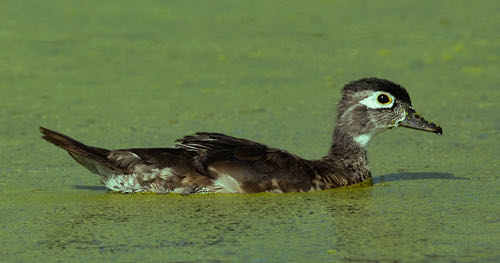- Established 1982 -HOME: www.hiltonpond.org
THIS WEEK at HILTON POND Subscribe for free to our award-winning nature newsletter (Back to Preceding Week; on to Next Week) |
DUCKWEED BATTLES In the summer of 2017, the waters of Hilton Pond took on an entirely new appearance with the uninvited arrival of Rootless Duckweed, Wolffia columbiana. It came with vengeance and that year grew so quickly it soon covered every square inch of water surface. Although we don't know how the duckweed got here--maybe via ducks--we think we know the conditions that allowed it to flourish: An adjoining farm became the repository for sewage sludge and manure from a local turkey farm, after which heavy precipitations sent nitrogen- and phosphorus-rich run-off into the pond. Lawn fertilizer from a neighboring yard added even more excess nutrients every time it rained. It's a pretty safe bet duckweed made good use of these suddenly abundant growth-stimulating compounds.
All text, maps, charts & photos © Hilton Pond Center That first year (above), the Rootless Duckweed--after blanketing the pond for four or five months--slowed down considerably with the onset of cold weather, encapsulated, and sank to pond bottom. The following Spring of 2018 those cells rejuvenated and propagated at an incredible rate, meaning the pond was again covered by a thin green carpet even before June arrived. The process has repeated itself every year since, so you might expect for this Summer of '22 we have yet another green sheen instead of clear water.
All text, maps, charts & photos © Hilton Pond Center Rootless Duckweed's alternate name of "Columbia Watermeal" arose because a handful rubbed between the palms has a granular or mealy feel (see photo above). Reputedly the world's smallest flowering plant, it is native to North America and does especially well in temperate and subtropical ponds with little water movement. Unless one has an entire flotilla of duckweed-eating ducks, there are only two ways to "get rid of" Watermeal: Chemical (with herbicides) and mechanical. (You could also drain a pond and start over, but that's a bit radical.) Needless to say, we weren't about to dump toxic chemicals into Hilton Pond--especially since most of those compounds also have potential for killing everything green, from trees and shrubs to pond side sedges and maybe even animal life. Herbicides, pesticides, insecticides, fungicides, and the like--they're just not our style.
All text, maps, charts & photos © Hilton Pond Center Mechanical removal involves methods such as raking the pond surface with nets or booms that pull the floating duckweed toward shore (above). This labor-intensive solution was out of the question, Hilton Pond being a full acre in size. So in 2019 the Center purchased a "semi-trash" gas-powered pump and tried to suction off the duckweed, using 30-foot-long three-inch hoses to skim the surface and deposit the refuse back on land above the water level--letting duckweed-free water run back into the pond. It was quite satisfying to watch the powerful pump suck up duckweed by the gallon, but the whole process turned out to be much too time-consuming. Floating sticks and leaves frequently fouled the intake, so we couldn't just let the pump run unattended lest it burn out.
All text, maps, charts & photos © Hilton Pond Center Thus, we gave up on the surface-vacuuming process, concluding that Floating Duckweed would be with us always but continuing to search for ways to control the plant. Upon learning aeration has been known to lessen duckweed infestations, we recently used most of the Center's 2022 Spring Fundraiser donations to order a HQUA Pond Aeration System (above) with a 1/2-horsepower electric compressor, two lengths of 100-foot weighted tubing, and two weighted diffusers at $750. With no electrical source at the pond, we also ordered a total of 350 feet of heavy-duty 12/3 outdoor extension cords at a buck a foot. We ran the four power cords from a grounded outlet outside the Center's old farmhouse, winding it through the woods to the pier on the pond. There we enclosed the compressor in a ventilated box we built from plywood. With that came the hardest part of the job: Climbing aboard the float at the end of the pier, casting off, and unrolling 100 feet of heavy tubing as we paddled out from shore. When we got to an appropriate spot near the dam, we connected the weighted diffuser to the end of the hose and lowered it until we felt it hit bottom. Then repeat: Return to the pier, extend the hose, and drop the second diffuser in place closer to the middle of the pond. With that we flipped the switch and two big circles of brown disrupted the duckweed as the air bubbles brought muck and mud to the surface (see photo below).
All text, maps, charts & photos © Hilton Pond Center We placed the compressor on a 24-hour timer so it ran two hours and rested 30 minutes, preventing it from getting too hot and frying itself. Then we sat back to see if this grand attempt would work. The set-up has been running since 11 May and we can't say we've seen any change thus far (except the bubbles are no longer as brown). Results might have been better had we gotten started in early April when the Rootless Duckweed first appeared, so it may take until next year before we can detect an effect. (We'll also have to wait to see the impact on the Center's monthly power bill. The entire effort may turn out to be an expensive experiment.)
All text, maps, charts & photos © Hilton Pond Center So far the duckweed hasn't been minimized by the bubblers and continues to cover the surface, but we're pretty confident fish and frogs and other aquatic organisms are benefiting from a now-aerated pond environment that has been pretty stagnant most of the year--especially during those summers when water level is low due to drought. If nothing else the two 30-foot-diameter circles (above) continue to bubble away, giving us evidence the 350' of extension cord is intact and the compressor remains up and running. We're hoping those constantly popping air bubbles don't accelerate summertime evaporation of the pond water, especially if 2022 continues to get insufficient rainfall.
All text, maps, charts & photos © Hilton Pond Center NOTES: Folks have suggested we establish a flock of white Mallards at Hilton Pond Center to help control Rootless Duckweed, but there's no way we'd do that. (Our native Wood Ducks--molting female above--do chow down on Watermeal, but they're too few to make any difference; besides, they're not here much in summer when the plant is dominant.) Readers likewise recommend adding sterile Grass Carp to the pond, a bad idea--as we discovered 30 years ago when someone surreptitiously dumped ten 12"-long carp into the impoundment. They all survived and eventually consumed every bit of of aquatic vegetation, jerking it up by the roots from pond bottom. It was then the pond started to become unbalanced, likely enhancing the possibility Rootless Duckweed could take over. The remaining two Grass Carp--both reaching an unbelievable 40 pounds---finally died and washed ashore about 15 years back, delighting our local Black Vultures. They pond has never recovered fully.
All text, maps, charts & photos © Hilton Pond Center We've heard that Koi fish (shown above in a simulated image of our new aeration system) have a taste for duckweeds (including Watermeal) but won't eat much else in a pond. Although Koi, too, are non-native, they're unlikely to take over and could end up as food for our population of Large-mouth Bass. We may give several Koi a chance to become Biological Control Heroes that go after our Rootless Duckweed menace at Hilton Pond Center. Stay tuned. (Comments pro or con about this plan are welcome at INFO.) All text, maps, charts & photos © Hilton Pond Center A "NEW" MOTH Always on the lookout for new species at Hilton Pond Center, this week (16 July) we encountered a white moth we've probably seen before but never actually identified. (We confess we don't work as hard as we should on the Center's moth inventory. It's just not feasible to spend the night studying nocturnal insects after banding birds dawn to dusk on a regular basis.) Getting an image of this particular specimen (below) was easier than with many moths since it was in its typical posture--resting with wings flat and extended, this time on an Eastern Redbud leaf. Plus, it was posing in full daylight, although adults can sometimes be collected and photographed after dark at light traps.
All text, maps, charts & photos © Hilton Pond Center At first we thought our "new" one-inch-wide lepidopteran was a Large Lace-border, Scopula limboundata, one of many members of the Geometrid Family. (Moths in the Geometridae typically have thin bodies and rest with wings outstretched. The scientific name is derived from "geo-meter"--the "earth-measurer"--because of the way these moths' inchworming larvae seem to delineate distances.) We were corrected by Ken Childs, an experienced moth enthusiast who said it was a look-alike species--the Rippled Wave, Idaea obfusaria. This native North American moth is relatively common in the southeastern and southcentral U.S. Although exceedingly variable in patterning, it is identifiable by a prominent more-or-less-dark spot on each of its four wings, plus three thin wavy greenish or brownish transverse lines. The hindwing markings are not as lace-like as those in Large Lace-border. (Note that all four wings are delicately fringed.)
All text, maps, charts & photos © Hilton Pond Center Rippled Waves typically produce one brood per year. The caterpillars are long, skinny inchworms are polyphagous, "feeding on dead and live plant tissues of many trees, shrubs, and forbs." They may dine on wildflowers known as Meadow-Beauty, Rhexis spp. (Virginia Meadow-Beauty, above), which happen to be a favorite of Large Lace-border larvae. All text, maps, charts & photos © Hilton Pond Center HILTON POND SUNSETS "Never trust a person too lazy to get up for sunrise
All text, maps, charts & photos © Hilton Pond Center Sunset over Hilton Pond, 21 July 2022 A "typical" midsummer sunset when clouds are around in Don't forget to scroll down for lists of Hilton Pond supporters and of all birds banded and recaptured during the period. Photoshop image post-processing for this page employs |
|---|
|
"This Week at Hilton Pond" is written and photographed by Dr. Bill Hilton Jr., executive director of Hilton Pond Center for Piedmont Natural History
|
|
|
Please refer "This Week at Hilton Pond" to others by clicking on this button: |
|





















 Please report your
Please report your